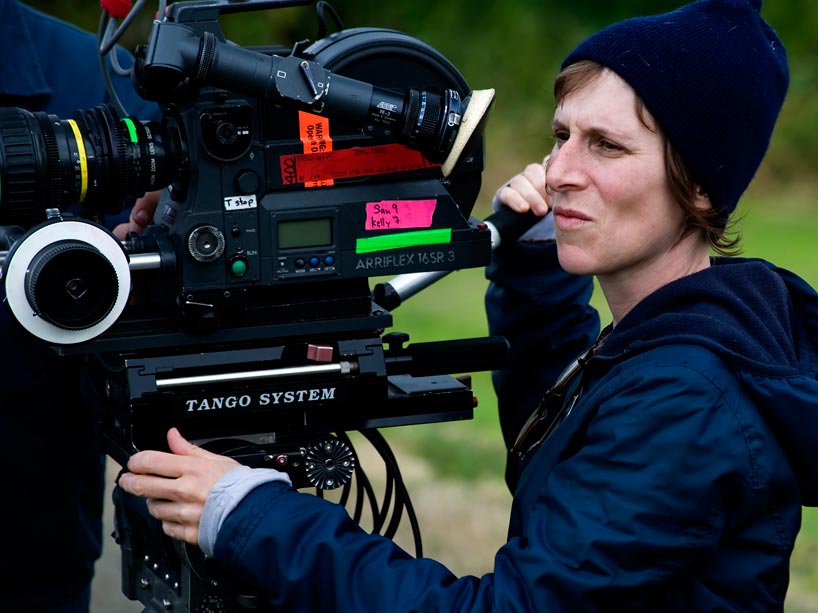Kelly Reichardt discusses the art of filmmaking

Photo: Filmmaker Kelly Reichardt visited Ryerson on November 2 as part of the inaugural Lucy Molnar Wing Lecture.
The films of Kelly Reichardt have attracted big-name stars and span genres, but they are produced outside the Hollywood system on budgets never exceeding $2 million. They have shown at film festivals and earned consistent critical acclaim, but her contemplative approach is (in the words of the Guardian newspaper) “wonderfully at odds with our expectations of the medium.” How does such a personal and idiosyncratic voice survive and thrive? On November 2, the director of Meek’s Cutoff, Certain Women, and Wendy and Lucy discussed the nuts-and-bolts of her craft in an onstage Q&A at the Rogers Communication Centre, as part of Faculty of Communication and Design’s first Lucy Molnar Wing Lecture Series.
Named in honour of the late Lucy Molnar, an advocate for film and photography in Canada, the new series will host acclaimed and inspiring filmmakers and photographers. “It’s always of particular interest to study the truly independent filmmaking working in the American context,” said Alexandra Anderson, professor at FCAD, who conducted the Q&A. “Kelly Reichardt is such a filmmaker: unapologetically independent. Raised in Florida, studied in Boston, and based in New York City, her films are mainly set in the small towns and wide-open spaces of the Midwestern and western part of the United States.”
Sound
After playing a scene from Old Joy (2005) featuring the protagonists’ visit to a hot spring, Reichardt revealed that the scene’s dense soundscape was almost entirely constructed in post-production: “It got more and more crowded—first with this big Russian family, and then these angry hippies, because we were taking over the tubs. It was really a hard day, and the sounds had to be recreated later after I was back on the east coast.” The sound of the water was created by a foley artist who poured buckets of water from the roof of his parents’ house onto rocks placed at the edge of a pool. The bird sounds were sourced from an LP of wilderness sounds, but this led to its own problems. “I just remember the very first Q&A someone raising their hand and saying, ‘Oh, that’s an east coast bird; that bird would never be in Oregon…’ I was so demoralized, and now I’m such a crank about bird sounds.”
Reichardt’s use of music has varied from film to film. On her first film, River of Grass, she filled the soundtrack with unlicensed music that would later have to be replaced. On Old Joy, she commissioned an original score by Yo La Tengo: “I look back and I’m like, ‘God, there’s too much music in that film.’ But y’know, you’re working with your friends and they’re making all this beautiful music for you.” For her next film, she used no music at all: “Wendy and Lucy is based on a short story called ‘Train Choir,’ and the idea was to use the trains and the sounds of the city in the places where one would use score.”
Images
The $2 million revisionist western Meek’s Cutoff (2010) depicts the true story of six settlers lost in the Oregon desert during the 1840s, and represents Reichardt’s most technically ambitious achievement. Her commitment to historical accuracy also made for a complicated shoot. “We got wagons that were from the period,” she said. “We used oxen instead of horses, which… never again. There’s always the question of, ‘Why don’t people use oxen in westerns? It wouldn’t be horses, it would be oxen.’ They’re wild bull. And they don’t back up, so you can’t back into a shot—you’re always moving forward.”
Though the film captures striking shots of the Oregon landscape, Reichardt committed herself to a rigorous visual logic. “It’s very beautiful out there, but we had a rule of ‘No beauty shots.’ There can’t be any shots for the sake of beauty. Landscape always has to be working in service of the scene.” The approach stemmed from the settlers’ diaries, which Reichardt used as source material. “At the beginning they talk about the majesty of the landscape, and heaven on earth, and all of this poetic thinking… and by the time they are six months into their walk, they’re like, ‘Ate the beans… dug the hole… put up the tent…’ The writing just becomes a to-do list. That’s kind of how we were trying to do it: there’s no more being overwhelmed by the beauty. You’re past that. Now you’re just in the thick of it.”
Actors
Despite their low budgets, Reichardt’s films have increasingly attracted A-list talent, including Michelle Williams, Jesse Eisenberg, Dakota Fanning, Laura Dern and Kristen Stewart. “It’s part of the rules of getting your film financed,” said Reichardt. “Even when you’re making a million-dollar film, it’s someone’s million dollars. It’s nothing when you’re out trying to pull this off.”
Working around actors’ schedules can often be a challenge, and rarely allows for a protracted rehearsal period: “I met Peter Sarsgaard and we were in a boat and it was like, ‘Can you drive the boat now, by the way? And can you take off those sunglasses and put this hat on?’ It’s all meeting people while you’re in the soup of it.” On the other hand, the low-budget conditions can facilitate a greater sense of collaboration and camaraderie. “They’re used to working on movies where they’re in their trailer and are kinda bored,” said Reichardt. “In this, we’re a very small crew and we need all hands on deck, so they were helping us push trucks out of… well, Jesse was driving the truck into the ditch, but he would help us get it out.
“Sometimes I think actors want a different experience. We go off to faraway places where nobody’s going to be trying to take their picture or bothering them.”
